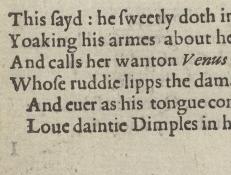Terms of use
Images that are under Folger copyright are licensed under a Creative Commons Attribution-ShareAlike 4.0 International License. This allows you to use our images without additional permission provided that you cite the Folger Shakespeare Library as the source and you license anything you create using the images under the same or equivalent license. For more information, including permissions beyond the scope of this license, see Permissions. The Folger waives permission fees for non-commercial publication by registered non-profits, including university presses, regardless of the license they use. For images copyrighted by an entity other than the Folger, please contact the copyright holder for permission information.
Copy-specific information
Creator: Richard Barnfield
Title: The affectionate shepheard. Containing the complaint of Daphnis for the loue of Ganymede.
Date: London : Printed by Iohn Danter for T. G[ubbin] and E. N[ewman] and are to bee sold in Saint Dunstones Church-yeard [sic] in Fleetstreet, 1594.
Repository: Folger Shakespeare Library, Washington, DC, USA
Call number and opening: STC 1480, title page & sigs. C1v-C2r, C3v-C4r, E3v-E4r, G1v-G3r
View online bibliographic record
Erin A. McCarthy, "The affectionate shepheard: earliest printed allusion to Shakespeare's Venus and Adonis," Shakespeare Documented, https://doi.org/10.37078/189.
Folger Shakespeare Library, STC 1480. See Shakespeare Documented, https://doi.org/10.37078/189.
Richard Barnfield’s description of “earth-delving conies” in The Affectionate Shepheard is most likely an early allusion to the “earth-delving conies” in Shakespeare’s Venus and Adonis (1593), line 687 in modern editions.
The Shakspere Allusion-Book lists other possible similarities, including the following passages:
Shakespeare:
For misery is trodden on by many,
And being low never relieved by any.
Barnfield:
Humility is misery relieu’d,
But Pride in neede of no man is regarded;
Barnfield also echoes a line from Lucrece:
Shakespeare:
But Beautie in that white entituled,
From Venus doues doth challenge that faire field...
Barnfield:
Oh foule Eclipser of that fayre sun-shine,
Which is intituled Beauty in the best;
It is hard to say whether these verbal similarities were deliberate or the result of a poetic culture that valued imitatio and the use of common images and tropes. Nevertheless, the similarities here and in Barnfield’s later Cynthia, the homoeroticism of much of Barnfield’s verse, and Barnfield’s praise for Shakespeare in “A Remembrance of Some English Poets” has led some scholars to propose that Barnfield might be the so-called “Rival Poet” of Shakespeare’s sonnets.
Two copies of The Affectionate Shepheard are known to survive: one in the British Library and another at the Folger Shakespeare Library. The Folger copy, purchased by Mr. Folger himself, is the one shown here.
Written by Erin A. McCarthy
Sources
Charles Charles, “Richard Barnfield, Marlowe, and Shakespeare.” Notes and Queries, series 9, 8.197 (1901): 277–79.
George Klawitter, ed., Richard Barfield: The Complete Poems (Selinsgrove: Susquehanna University Press; London and Toronto: Associated University Presses, 1990).
Sonia Massai, “Barnfield, Richard (bap. 1574, d. 1620).” in Oxford Dictionary of National Biography, online ed., edited by Lawrence Goldman. (Oxford: Oxford University Press, 2004) <http://www.oxforddnb.com/view/article/1487>.
Sasha Roberts, Reading Shakespeare’s Poems in Early Modern England (New York: Palgrave, 2003).
F.J. Furnivall, C.M. Ingleby, and L. Toulmin Smith, comps, The Shakspere Allusion-Book: A Collection of Allusions to Shakspere from 1591 to 1700, ed. John Munro (London: Oxford University Press, 1932): 1:17-18
Last updated June 8, 2020

















